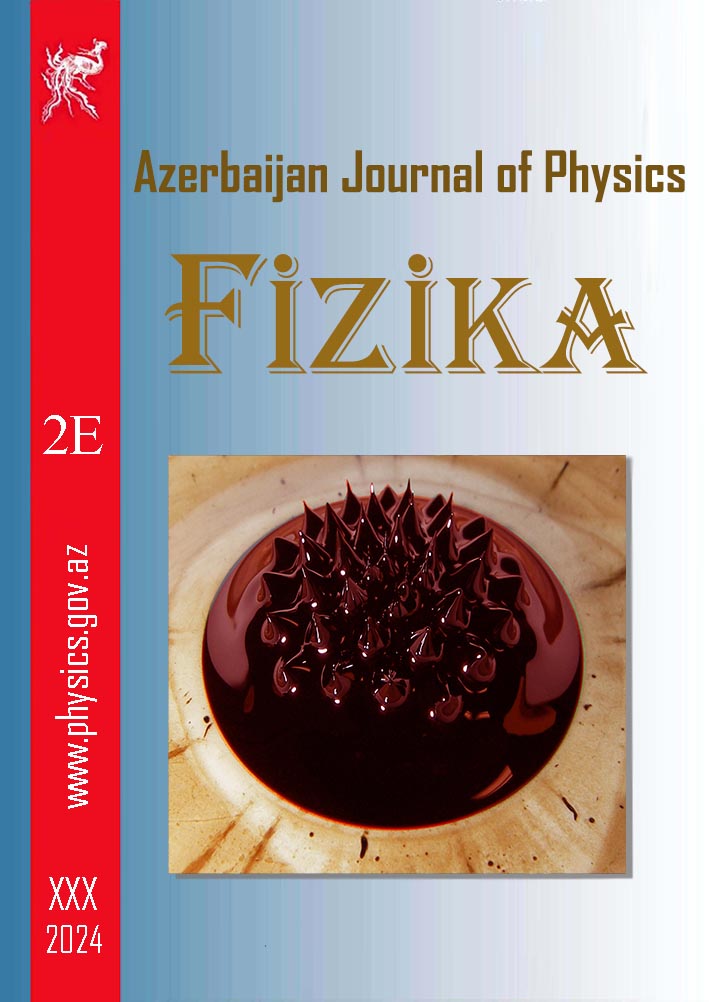ABSTRACT
The electronic and structural properties of vacancy in graphene and doping of graphene with Ge calculated by the density functional theory (DFT) method within the
Generalized Gradient Approximation (GGA). To simulate the vacancy effects have been studied 54 and 18 atom supercells to account for possible program software.
Ferromagnetic spin ordering of vacancy of carbon atoms have been studied. It was shown that ferromagnetic ordering of the carbon atoms vacancies are located near the
doping Ge atom. In addition DOS for 18 graphene atoms doped by Ge for s, p, d state have been calculated.
Keywords: ab initio calculation, DFT, ATK, graphene, Ge-doped, supercell, DOS, magnetic moment.
PACS: 31.10.+z, 31.15.E−, 75.50.Gg.
Received: 10.03.2020
AUTHORS & AFFILIATIONS
Institute of Physics, 131 H. Javid, Baku Az-1143, Azerbaijan
E-mail: suma_huseynova.physics@mail.ru
|
REFERENCIES
[1] P. Lian, X. Zhu, H. Xiang, Z. Li, W. Yang, H.Wang. Enhanced cycling performance of Fe3O4 – graphene nanocomposite as an anode material for lithium-ion batteries. Electrochim Acta, 56:834-840, 2010. doi:10.1016/j.electacta.2010.09.086.
[2] AK Rai, J. Gim, LT Anh, J Kim. Partially reduced Co3O4/graphene nanocomposite as an anode material for secondary lithium ion battery. Electrochim Acta, 100:63-71, 2013. A simple and rapid urea-assisted, auto-combustion approach for the synthesis of high-performance Co3O4/graphene nanocomposite anode is reported, DOI:10.1016/j.electacta. 2013.03.140.
[3] C.W.J. Beenakker. Colloquium: Andreev reflection and Klein tunneling in graphene, Rev. Mod. Phys., 2008, 80, 1337–1354, DOI:https://doi.org/10.1103/RevModPhys.80.1337.
[4] A.H. Castro Neto, F. Guinea, N.M.R. Peres, K.S. Novoselov and A.K. Geim. The electronic properties of graphene, Rev. Mod. Phys., 2009, 81,109–162, DOI: 10.1103/RevModPhys.81.109.
[5] S.D. Sarma, S. Adam, E.H. Hwang and E. Rossi. Electronic transport in two dimensional graphene, Rev.Mod.Phys., 83, 407–470, 2011. DOI:https://doi.org/10.1103/RevModPhys. 83. 407.
[6] R.R. Nair, P. Blake, A.N. Grigorenko, K.S. Novoselov, T.J. Booth, T. Stauber, N. MR. Peres and A.K. Geim. Fine structure constant defines visual transparency of graphene, Science, 320, 1308, 2008. doi: 10.1126/science.1156965.
[7] A.A. Balandin, S. Ghosh, W. Bao, I. Calizo, D. Teweldebrhan, F. Miao and C.N. Lau. Superior thermal conductivity of single-layer graphene, Nano Lett., 8, 902–907, 2008. doi/10.1021/nl0731872.
[8] B. Luo, B. Wang, X.L. Li, Y.Y. Jia, M.H. Liang and L.J. Zhi. Graphene-confined Sn nanosheets with enhanced lithium storage capability, Adv. Mater., 24, 3538–3543, 2012. DOI: 10.1002/adma.201201173.
[9] C.H. Xu, B.H. Xu, Y. Gu, Z.G. Xiong, J. Sun and X.S. Zhao. Graphene-based electrodes for electrochemical energy storage, Energy Environ. Sci., 6, 1388–1414, 2013 DOI: 10.1002/adma.201201173.
[10] C. Lee, X.D. Wei, J.W. Kysar and J. Hone. Measurement of the elastic properties and intrinsic strength of monolayer graphene, Science, 321, 385–388. 2008. doi: 10.1126/science.1157996.
[11] M.M. Loghavia,b, H. Mohammadi-Maneshb, R. Eqraa, A. Ghasemia and M. Babaieea. DFT Study of Adsorption of Lithium on Si, Ge-doped Divacancy Defected Graphene as Anode Material of Li-ion Battery Phys. Chem. Res., Vol. 6, № 4, 871-878, December 2018. DOI: 10.22036/pcr.2018.148943.1543.
[12] S.S. Huseynova. AB initio study of Si -doped monolayer graphene, Transactions of National Academy of Science of Azerbaijan,series of physics-mathematical and technical, Physics and Astronomy, № 2, 2020.
[13] A. Acun, L. Zhang, P. Bampoulis, M. Farmanbar, A. van Houselt, A.N. Rudenko, M. Lingenfelder, G. Brocks, B. Poelsema, M.I. Katsnelson, and H.J.W. Zandvliet Germanene. The germanium analogue of graphene, J. Phys.: Condens. Matter 27, 443002 (11 pp), 2015. doi:10.1088/0953-8984/27/44/443002.
[14] B. Lalmi, H. Oughaddou, H. Enriquez, A. Kara, S. Vizzini, B. Ealet, B. Aufray. Epitaxial growth of a silicene sheet, Appl. Phys. Lett. 97, 223109, 2010. https://doi.org/10.1063/1.3524215.
[15] Z. Guan, W. Wang, J. Huang, X. Wu, Q. Li, J. Yang. Metal-Free Magnetism and Half-Metallicity of Carbon Nitride Nanotubes: A First-Principles Study, J. Phys. Chem. C 118, 39, 22491-22498, 2014. https://doi.org/10.1021/jp508617k.
[16] E. Aktürk, C. Ataca, S. Ciraci. Effects of silicon and germanium adsorbed on graphene, Appl. Phys.Lett.96,123112, 2010; https://doi.org/10.1063/1.3368704
[17] J.G. Ren, Q.H. Wu, H. Tang, G. Hong, W. Zhang, S.T. Lee. Germanium–graphene composite anode for high-energy lithium batteries with long cycle life, J. Mater. Chem. A 1, 1821 2013. https://doi.org/10.1039/C2TA01286C.
[18] M. Tripathi, A. Markevich, R. Böttger, S. Facsko, E. Besley, J. Kotakoski, T. Susi. Implanting Germanium into Graphene ACS Nano 12, 4641, 2018. https://doi.org/10.1021/acsnano.8b01191.
[19] M. Sajjad, N. Singh, U. Schwingenschlögl. Strongly bound excitons in monolayer PtS2 and PtSe2 Appl. Phys. Lett. 112, 043101 2018, https://doi.org/10.1063/1.5010881.
[20] N. Singh, Udo Schwingenschlögl. A Route to Permanent Valley Polarization in Monolayer MoS2, Adv. Mater. 29(1), 1600970, 2017. DOI: 10.1002/adma.201600970.
[21] M.H. Mohammed, A.S. Al-Asadi, F.H. Hanoon. Superlattices Microstructures 129, 14-19 (2019)Electronic structure and band gap engineering of bilayer graphene nanoflakes in the presence of nitrogen, boron and boron nitride impurities, DOI:10.1016/j.spmi. 2019.03.012.
[22] M.H. Mohammed, A.S. Al-Asadi, F.H. Hanoon. Solid State Commun. 282, 28-32, 2018. Semi-metallic bilayer MS2 (M= W, Mo) induced by Boron, Carbon, and Nitrogen impurities, Solid State Communications,Pub.Date : 2018. DOI: 10.1016/j.ssc.2018.07.011.
[23] Z.M. Ao, J. Yang, S. Li and Q. Jiang. Enhancement of CO detection in Al doped graphene Chem. Phys. Lett., 2008,461, 276, https://doi.org/10.1016/j.cplett. 2008.07.039.
[24] Lv Ruitao and M. Terrones. Towards new graphene materials: Doped graphene sheets and nanoribbons, Mater.Lett.78, 209-218, 2012. DOI:10.1016/j.matlet.2012.04.033.
[25] M Yu Arsent’ev, A V Prikhodko, A V Shmigel, T L Egorova and M V Kalinina. Doping graphene with a monovacancy: bonding and magnetism, Journal of Physics: Conference Series 661, 012028, 2015. doi: 10.1088/1742-6596/661/ 1/ 012028 http://quantumwise.com.
[26] M. Ernzerhofa and G.E. Scuseria. Assessment of the Perdew–Burke–Ernzerhof exchange-correlation functional, Journal of Chemical Physics, v.110, No 11. 5029-5036, 1999.
[27] S.A. Tolba, K.M. Gameel, B.A. Ali, H.A. Almossalami and N.K. Allam. The DFT+U: Approaches, Accuracy, and Applications, 2018. DOI:10.5772/intechopen.72020.https://www.sciencedirect. com/topics/ chemistry/generalized-gradient-approximation, 1-30.
[28] A. Pablo Denis. Chemical Reactivity and Band-Gap Opening of Graphene Doped with Gallium, Germanium, Arsenic, and Selenium Atoms, DOI: 10.1002/cphc.201402608, 2014. Wiley-VCH Verlag GmbH & Co. KGaA, Weinheim.
|
